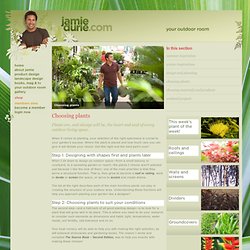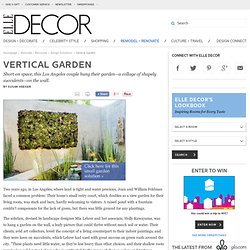

: Flowall. Anthurium** Eviter les excès d'eau.

Beaucoup de lumière est nécessaire pour voir naître de nouvelles inflorescences. Asparagus*** The aesthetic appeal depends on the species. Very tough under bad conditions. Requires a lot of water. Asplenium** Requires humidity, quite a lot of water and light. Begonia** Several species with succulent leaves, and more or less flowers. Christmas cactus (Schlumbergera)** Very resistant. Maidenhair* Requires moist soil, very high humidity, and low light intensity. Chamaedorea** Requires regular watering. Croton (Codiaeum)* Does not require too much water or heat.
Dieffenbaccha** Requires bright light but does not need much water. Living Walls plant list. Air Plants Gallery. The Best Mail-Order Plant Sources. Living Wall Plant Selection Lessons - Industrial.wmv. Plants. Cactusshop.com. 2010CSCatalog.pdf (application/pdf Object) Succulent Plant List K. The Cactus Collection. Grow a vertical garden in your home - Indoor Gardening - Gardens.
Succulent and Cacti Cutting Assortment by VivaFlora. Plant Lists. When it comes to planting, your selection of the right specimens is crucial to your garden's success.

Where the plant is placed and how much care you can give it will dictate your choice. Get this right and the hard part’s over! Step 1: Designing with shapes first and plants later When I sit down to design an outdoor space—from a small balcony or courtyard, to a sprawling garden or resort—the plants I choose aren’t selected just because I like the look of them; one of the main priorities is that they serve a structural function. That is, they grow to become a roof or ceiling, work to divide or screen the space, or serve to accent and create drama. The list at the right describes each of the main functions plants can play in creating the structure of your outdoor area. Step 2: Choosing plants to suit your conditions The second step—and a hallmark of all good planting design—is to look for a plant that will grow well in its place. Vertical Garden-Page 2. Two years ago, in Los Angeles, where land is tight and water precious, Joan and William Feldman faced a common problem: Their home's small entry court, which doubles as a view garden for their living room, was stark and bare, hardly welcoming to visitors.

A raised pond with a fountain couldn't compensate for the lack of green, but there was little ground for any plantings. Planting Green Roofs and Living Walls (9780881929119): Nigel Dun. Green Roof Plants: A Resource and Planting Guide (9780881927870) Lithophyte. Examples of lithophytes include several Paphiopedilum orchids, ferns, many algae and liverworts.

Species that only grow on rock or gravel are obligate lithophytes. Species that grow on rocky substrate and elsewhere are facultative lithophytes. As nutrients tend to be rarely available to lithophytes or chasmophytes, many species of carnivorous plants can be viewed as being pre-adapted to life on rocks. By consuming prey, these plants can gather more nutrients than non-carnivorous lithophtytes.[1] Examples include the pitcher plants Nepenthes campanulata and Heliamphora exappendiculata, many Pinguicula and several Utricularia species. Jump up ^ McPherson, S.R. (2010). Epiphyte. An epiphyte is a plant that grows non-parasitically upon another plant (such as a tree), and derives its moisture and nutrients from the air, rain, and sometimes from debris accumulating around it instead of the structure it is fastened to.

An epiphytic organism that is not a plant is not called an epiphyte.[1] Epiphytes are usually found in the temperate zone (e.g., many mosses, liverworts, lichens, and algae) or in the tropics (e.g., many ferns, cacti, orchids, and bromeliads).[2] Epiphytes provide a rich and diverse habitat for other organisms including animals, fungi, bacteria, and myxomycetes.[3] Epiphyte is one of the subdivisions of the Raunkiær system. An epiphytic bromeliad The term epiphytic derives from the Greek epi- (meaning 'upon') and phyton (meaning 'plant').
Epiphytic plants are sometimes called "air plants" because they do not root in soil. Physiognomy[edit] Some epiphytic plants are large trees that begin their lives high in the forest canopy. Gro-Wall™ Plant List. Living Walls plant list. Vertical garden: What worked, what didn't. As we've been reporting, vertical garden design continues to evolve as designers push the limits of what's possible and discover what works -- or what doesn't. Last year, Gregory Thirloway and Glen Fretwell’s company, Inside/Out Design, was working for a client in West Hollywood who wanted to have a hanging garden that was a “living painting,” executed in the Impressionist style, all swirls and swaths of color. Approaching it like a museum-quality work of art — Thirloway graduated from Art Center in Environmental Design — they first had the frame done: custom-fabricated 4" x 1.75" extruded aluminum tubing joined to make a rectangular box.
Then, over several days in January, the plants were transplanted into the 1-inch spaces in the box’s interior 8-gauge aluminum wire mesh. They chose varieties based on their growing patterns first, looking for lateral rather than vertical growth. Only then did they start to consider texture and color palette. -- Jeff Spurrier.